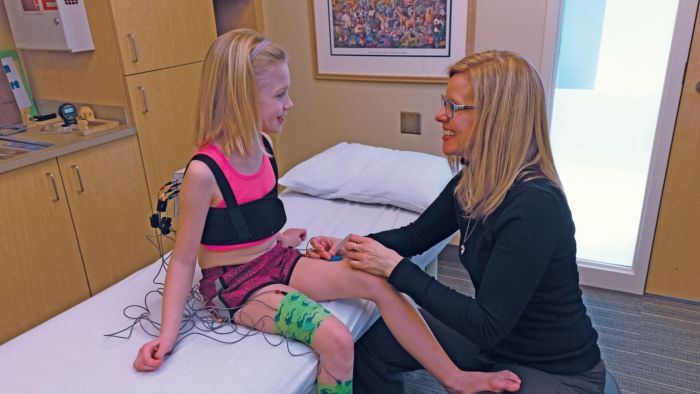The collaboration of scientists and clinicians is part of Gillette’s mission and work to improve the understanding and care of individuals with disabilities and our effort to impact clinical care outside of our hospital walls. Recent work regarding at-home gait analysis supports these goals. Andrew Georgiadis, MD, pediatric orthopedic surgeon, and Michael Schwartz, PhD, from the James R. Gage Center for Gait and Motion Analysis research team, have been collaborating for years to make gait analysis more accessible to more families.
Instrumented gait analysis is a time- and labor-intensive process in which human walking is analyzed. The data collected are useful for planning treatment and monitoring the status of patients with gait impairments. However, conducting an instrumented gait test requires space, people, time, and family travel. Additionally, the testing is performed in an artificial environment that may not simulate a patient’s real-world walking conditions.
Drs. Georgiadis and Schwartz believe if clinicians and researchers could acquire key gait parameters remotely, that would enable assessments with fewer resources, in the patient’s native environment, and with repeated measures. It could also allow for assessments after minor interventions, track recovery after major interventions, and open the door to large-population research and other uses.
“A useful algorithmic analysis of gait videos acquired at home would be easy and quick to use, easily interpretable, and consistent between observations to give users actionable information (minimize bias and variance),” notes Dr. Schwartz.
Dr. Schwartz has collaborated with machine learning researchers at Stanford University to make gait data predictions based on single-camera videos. The proof-of-concept study was published in Nature Communications. He is now working with clinicians at Gillette to test and expand the use of machine learning to predict gait data in patients’ home environments.
“Based on a pilot study in 2022-2023, we know that this algorithmic prediction works well enough for large-population research. Now, we want to see if it can be good enough for individual patient decision-making,” says Dr. Georgiadis.
Though still early in the two-to-three-year process, Drs. Georgiadis and Schwartz are hopeful that their follow-up investigation is not just successful, but an effort that changes clinical care for families and providers.
Who to Refer for Gait and Motion Analysis
Although people might have similar walking patterns, the way their muscles and joints work together can vary widely. Gait and motion analysis helps to understand and recognize how orthopedic, neurological, and muscular conditions can hinder the movements important for daily living. The innovative video and computer technology at Gillette Children’s James R. Gage Center for Gait and Motion Analysis captures movements, muscle activity, and forces that the eye can’t see. Information from gait analysis — together with imaging scans, medical history, and the results of other evaluations — helps your care team recommend the best treatments for a wide variety of conditions that disrupt movement.
Who Can Benefit From Gait and Motion Analysis?
Children and young adults with complex conditions and injuries who have concerns about their walking function and ability are often candidates for gait and movement analysis. Your patient might benefit from a gait assessment if they have:
- Cerebral palsy
- Brain injury and related neurotrauma
- Complex movement disorders
- Conditions that cause toe-walking
- Limb-length discrepancy and limb differences
- Misaligned bones and foot abnormalities
- Spina bifida
- Other neurological or orthopedic conditions
- Amputations
What About Movement Analysis for Upper Extremities?
Although gait analysis is primarily used to understand walking problems, the movement analysis technology at Gillette can document the movement and muscle activity of the arms and hands. Your patient may benefit from an upper extremity assessment if they have hand and upper extremity movement problems.
Can a Teen Get a Movement Analysis?
Yes, a teen might have motion analysis for the first time because their condition has begun causing pain and stiffness with age. Most often, those who experience difficulty with movement as children need ongoing evaluation and treatment as they transition into teens and adults.
Get Partners in Care Stories in your inbox!
Subscribe to Partners in Care Journal, a newsletter for healthcare providers and community health professionals.
Subscribe Today Home Page
Home Page



